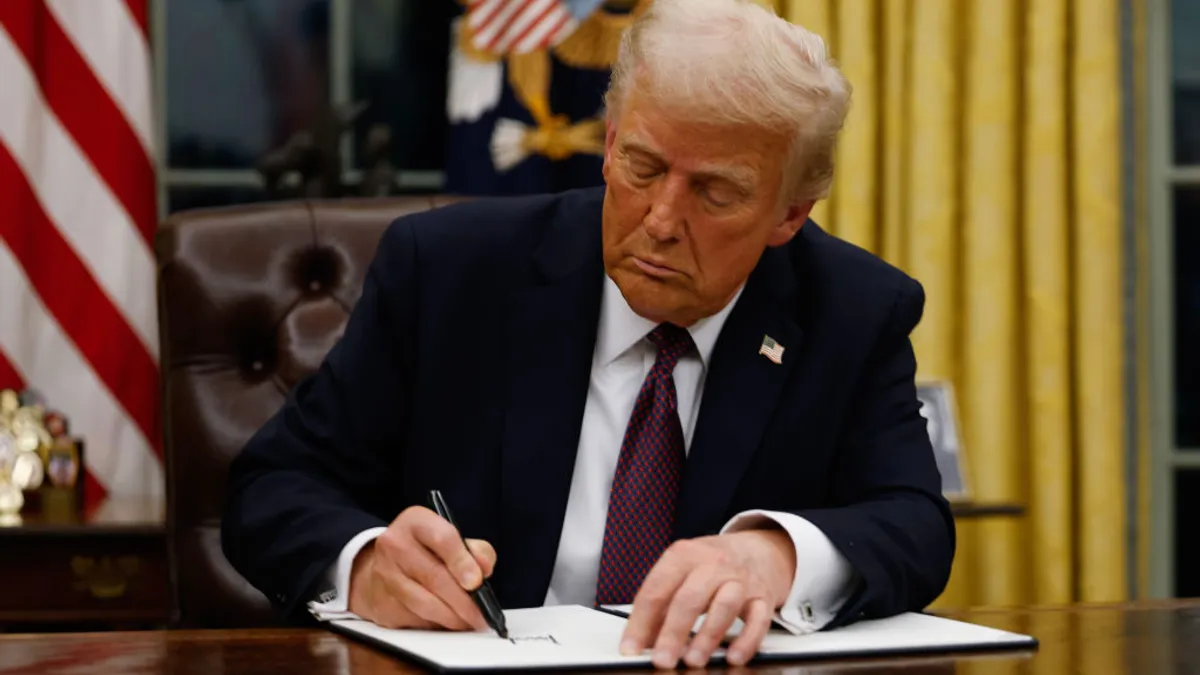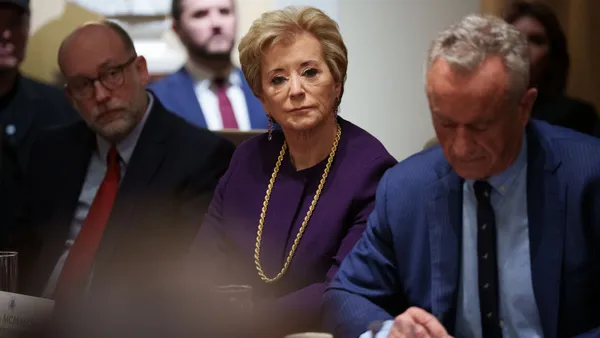Dive Brief:
- Newly sworn-in President Donald Trump signed several executive orders Monday taking aim at Biden-era efforts to provide protections for LGBTQ+ students and increase educational access for Hispanic, Native American and Black students.
- In one executive order, Trump directed the U.S. government to only recognize two sexes — male and female — based on reproductive cells. Unlike Biden-era policies, which attempted to offer protections based on gender identity, the new order directs federal agencies to use its definition of sex to enforce laws, including Title IX.
- Then, on Tuesday, the Trump administration announced a directive ending the practice of Immigration and Customs Enforcement and Customs and Border Protection agents avoiding “sensitive” areas — including elementary and secondary schools, colleges, hospitals and churches — for enforcement actions.
Dive Insight:
Trump marked his first day in office with a flurry of executive actions, which also touched on healthcare, the workplace and the prison system.
Some of the directives drew condemnation from LGBTQ+ groups, which said they would harm transgender, nonbinary and intersex individuals. The order recognizing only two sexes does not clarify how it would classify intersex individuals, who have reproductive traits or other characteristics that don’t align with common definitions for males or females.
“The impact of these executive actions will be devastating — stripping away health care access, weakening workplace protections from abuse, inviting exclusion and harassment of vulnerable school children, and giving a green light to discrimination throughout public life,” Lambda Legal CEO Kevin Jennings said in a Monday statement.
High-profile conservatives, on the other hand, lauded the new executive order.
“Instead of trying to erase sex, the administration is recognizing it, celebrating it,” Tim Walberg, the Michigan Republican who chairs the House Committee on Education and Workforce, said in a statement Monday. “Doing so will give women and girls opportunities to thrive and excel on and off the field.”
Republicans, including Walberg, have voiced support for policies that bar transgender women from playing on women’s and girls’ sports teams.
Trump’s order defines “female” as someone who produces “the large reproductive cell” and “male” as someone who produces “the small reproductive cell.”
It says that “sex” is “not a synonym for and does not include the concept of ‘gender identity.’”
Federal funds, in turn, should not promote the notion that individuals can assess their own gender or that a spectrum of genders exists, the order said. It described such claims as false and labeled them “gender ideology” — a term often used by anti-LGBTQ+ activists to oppose rights for gay and transgender individuals, according to anti-hate groups.
It’s unclear how this assessment will immediately impact schools or their LGBTQ+ students.
The order also directs the U.S. Education Department to rescind several pieces of guidance, including a 2021 memo that said discriminating against gay or transgender individuals would violate Title IX, which bars sex discrimination in federally funded education programs. However, last year, a federal judge in Texas struck down the guidance and blocked the Education Department from enforcing it against education institutions in the state.
The 2021 memo had preceded the Biden administration’s sweeping Title IX rule that offered protections to LGBTQI+ students — regulations that were also struck down in court.
In an executive order targeting broader DEI efforts signed Tuesday, Trump called for the U.S. attorney general and the education secretary to issue joint guidance to all state education agencies and local school districts receiving federal funds regarding the measures and practices needed to comply with the U.S. Supreme Court’s 2023 decision striking down race-conscious admissions.
Trump also rescinded several Biden-era executive orders Monday from 2021 that sought to increase educational access to underrepresented students. Among their many goals, they aimed to increase federal funding access to minority-serving institutions, including historically Black colleges and universities and Hispanic-serving institutions.
The president likewise pulled back a 2024 executive order that established a White House initiative to increase educational access through Hispanic-serving institutions.
The initiative had several goals, including using federal programs to grow Hispanic-serving institutions’ educational capacity, identifying best practices for supporting their students’ economic mobility, and strengthening the governments’ recruiting activities on their campuses.
Anna Merod contributed to this story.









 Dive Awards
Dive Awards







